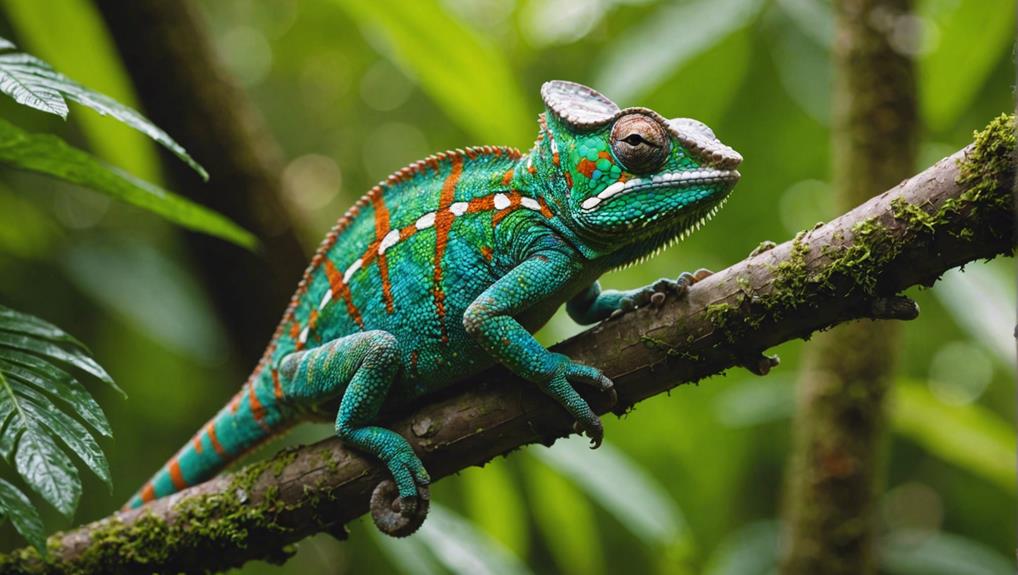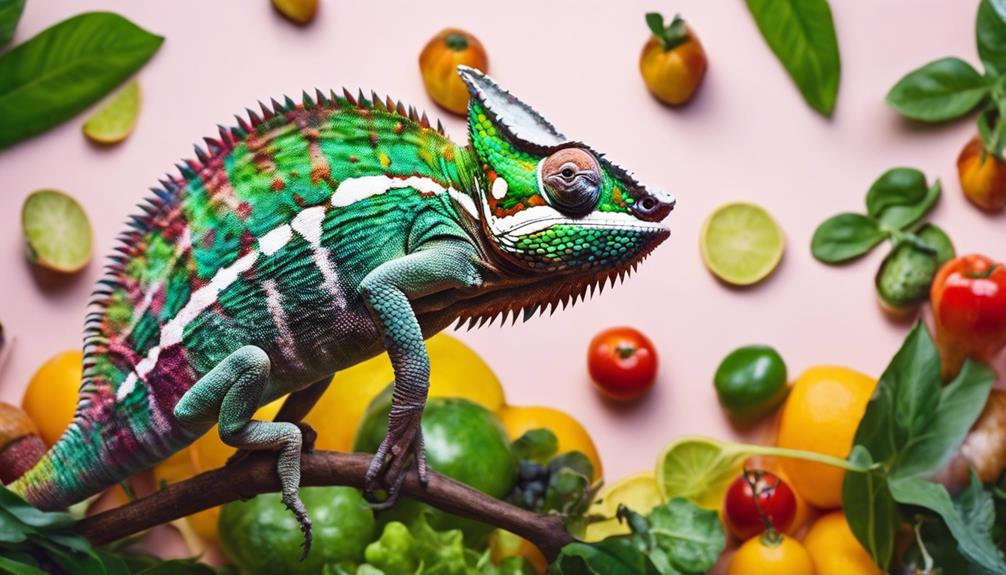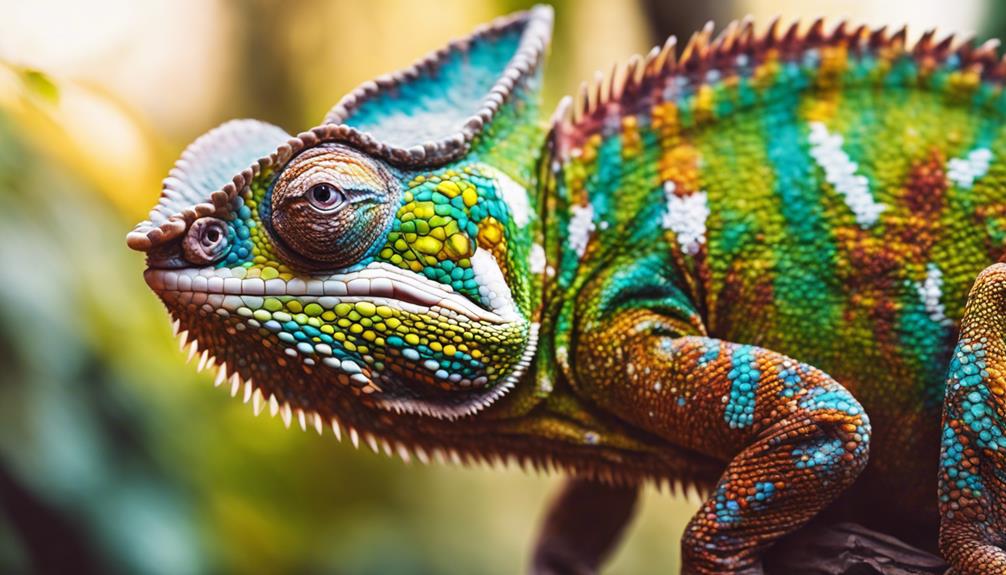Discover the Master of Disguise: The Verrucosus Chameleon
Found in Madagascar, the Verrucosus Chameleon is a master of adaptation, thriving in diverse habitats from dry forests to rainforests. Their vibrant colors and unique patterns serve as the perfect camouflage, allowing them to blend in seamlessly with their surroundings.
Males are particularly striking, displaying more colorful hues than their female counterparts. But it's not just about looks – their color-changing ability is a vital tool for communication, temperature regulation, and survival.
With exceptional eyesight and lightning-fast tongues, Verrucosus Chameleons are stealthy hunters, snatching up insects and small animals with ease. They're also fiercely territorial, with a lifespan of 3-5 years in the wild.
But their very existence is threatened by habitat destruction, making conservation efforts a pressing priority.
Learn more about the fascinating behaviors and conservation needs of these incredible creatures.
Habitat and Distribution
The Verrucosus Chameleon thrives in the diverse habitats of Madagascar, from its dry forests to its humid rainforests. You'll find these remarkable reptiles scattered across a wide geographical range on the island.
They adapt well to various climates, showcasing their incredible resilience and flexibility. Whether it's a parched, sun-baked forest or a lush, moisture-laden rainforest, the Verrucosus Chameleon has made it their home.
Understanding the climate preferences of these chameleons is key to appreciating their adaptability. They're not picky when it comes to temperature and humidity. In the dry forests, they handle intense heat and sparse water sources with ease. On the flip side, in the rainforests, they thrive in cooler, wetter conditions.
This adaptability speaks volumes about their survival skills and their ability to find comfort in extremes, a trait that's both fascinating and inspiring.
Their geographical range is extensive within Madagascar. You'll spot them in the central highlands, where temperatures can drop dramatically at night, and in the coastal regions, which offer a more stable, warm climate.
This broad range shows just how well they've adapted to the island's varied ecosystems. It's almost as if they embody the spirit of freedom, moving across the island and making the most of what each environment offers.
You might think such adaptability is rare, but for the Verrucosus Chameleon, it's just another day in Madagascar. By understanding their habitat and distribution, you gain insight into their incredible resilience and the diverse environments they call home.
Physical Appearance
When examining the Verrucosus Chameleon's physical appearance, you'll notice its vibrant coloration and unique patterns that help it blend into its surroundings.
This species typically exhibits a range of colors from greens to browns, often with striking bands or spots.
Additionally, the Verrucosus Chameleon is known for its large size and distinct morphological features, including a robust body and prominent casque.
Coloration and Patterns
Verrucosus chameleons boast vibrant coloration and intricate patterns that help them blend seamlessly into their natural habitats.
These reptiles are masters of disguise, displaying a range of colors that can change depending on their environment, mood, and even the time of year.
Gender differences play a significant role in their appearance. Males typically exhibit more striking and vivid colors compared to females, who generally have more subdued hues. The males' bright greens, yellows, and blues can turn heads, while females often show earthy tones like browns and greens.
Seasonal variations also influence their coloration. During the breeding season, males become even more colorful, showcasing their brightest shades to attract females and ward off rivals. Outside of this period, their colors may become more muted.
Patterns on the Verrucosus chameleon's skin, such as bands, spots, and stripes, further enhance their camouflage abilities. These patterns aren't just for show; they help the chameleon break up its outline and blend into the foliage, making it harder for predators to spot them.
Understanding these aspects of the Verrucosus chameleon's coloration and patterns is essential for appreciating their adaptability and survival strategies.
Size and Morphology
Beyond their mesmerizing colors and patterns, you'll find that these chameleons also exhibit unique size and morphological traits that set them apart.
The Verrucosus chameleon can grow up to 24 inches in length, with males typically larger than females. Their impressive growth rate means they reach adult size fairly quickly, sometimes within a year. This rapid development allows them to adapt swiftly to their environment, showcasing their resilience and adaptability.
In terms of body structure, the Verrucosus chameleon has a robust and elongated body with a prehensile tail that aids in climbing and balancing. Their limbs are strong and equipped with zygodactylous feet, meaning they've two toes pointing forward and two backward, which provides a firm grip on branches.
Their head features a pronounced casque, a bony crest that adds to their distinctive appearance and might play a role in thermoregulation and species recognition.
Their eyes are another standout feature, capable of moving independently, allowing them to scan their surroundings for prey and predators simultaneously.
These unique morphological traits make the Verrucosus chameleon a fascinating subject for those intrigued by the natural world's diverse adaptations.
Camouflage Abilities
When you think about the camouflage abilities of the verrucosus chameleon, their color-changing mechanism is key.
They adjust their hues to blend into their surroundings, aiding in environmental adaptation.
This fascinating skill helps them avoid predators and surprise prey.
Color-changing Mechanism
Understanding the color-changing mechanism of the Verrucosus Chameleon reveals its remarkable camouflage abilities.
At the heart of this process is cellular biology, where specialized cells called chromatophores come into play. These cells contain different pigments, responsible for the chameleon's vibrant color palette. By manipulating these chromatophores, the chameleon can adjust its skin color to blend seamlessly with its surroundings.
You might wonder how this works. It's all about pigment production and distribution. Chromatophores have layers, each containing various pigments like red, yellow, and brown. When the chameleon decides to change color, it expands or contracts these cells, altering how light reflects off its skin.
This incredible ability isn't just for hiding; it can signal mood, communicate with other chameleons, or even regulate temperature.
To see this in action is to witness nature's artistry. Imagine the freedom to change your appearance at will, adapting instantly to your environment.
The Verrucosus Chameleon embodies this freedom, using its unique biology to thrive. By understanding this mechanism, you gain insight into a fascinating aspect of the natural world, where survival and beauty intertwine.
Environmental Adaptation
The Verrucosus Chameleon's camouflage abilities allow it to blend seamlessly into its environment, making it a master of disguise. By changing its color, the chameleon effectively avoids predators, ensuring its survival in the wild.
This ability to adapt to various surroundings isn't just for predator avoidance; it also plays a vital role in temperature regulation. When the chameleon needs to warm up, it can shift to darker colors to absorb more heat from the sun. Conversely, it can turn lighter to reflect sunlight and stay cool.
You might be fascinated to know how this remarkable creature manages such precise control over its appearance. The chameleon's skin contains specialized cells called chromatophores, which expand and contract to change color.
This allows the chameleon to adjust its appearance in response to changes in its environment, seamlessly blending into foliage, branches, or even the ground.
Understanding the Verrucosus Chameleon's environmental adaptation gives you a glimpse into the incredible survival strategies of nature.
These adaptations not only keep the chameleon safe from predators but also help it maintain a suitable body temperature, showcasing the intricate balance of nature's design.
Hunting and Diet
Verrucosus chameleons are stealthy hunters, relying on their keen eyesight and lightning-fast tongues to catch prey.
When it comes to prey selection, these chameleons have a diverse diet, often hunting insects like crickets, grasshoppers, and moths. They don't just stop at insects, though; small invertebrates and other tiny creatures are also on their menu. This varied diet guarantees they get the nutrients they need to stay healthy and active.
Their feeding behaviors are fascinating to observe. Verrucosus chameleons use their exceptional vision to spot movement from a distance. Once they lock eyes on a target, they remain incredibly still, blending into their environment. It's all about patience and precision. When the moment is right, their tongue shoots out at lightning speed, catching the prey with a sticky tip.
You might be wondering how often these chameleons eat. Well, their feeding frequency can vary based on factors like age, size, and environment. Generally, younger chameleons eat more frequently than adults, as they need extra energy for growth. Adults typically hunt every few days, but this can change based on food availability and their overall health.
In captivity, it's vital to replicate their natural hunting conditions as much as possible. Offering a variety of insects and making them 'hunt' for their food can help keep them engaged and healthy. Understanding their hunting and diet is key to providing the best care for these incredible creatures.
Reproduction and Lifespan
When it comes to reproduction, Verrucosus chameleons have some fascinating behaviors that are essential for their species' survival. These chameleons engage in intricate courtship rituals to attract mates. Males display vibrant colors and perform specific movements to catch the attention of females. If the female is receptive, she'll allow the male to approach and mate.
Once mating has occurred, the female Verrucosus chameleon begins the process of laying her eggs. She typically digs a hole in the ground to deposit her eggs, ensuring they're safely buried. The number of eggs laid can vary, but it often ranges from 20 to 60 per clutch.
The egg incubation period is vital for the development of the young chameleons. Females dig a hole and lay their eggs, which can take several hours. The eggs are then covered with soil to protect them from predators and environmental conditions.
The eggs remain buried for about 6 to 12 months, depending on the temperature and humidity. Warmer conditions tend to speed up the incubation process, while cooler environments may prolong it.
Once the incubation period is complete, the young chameleons emerge from their eggs. They're fully independent and begin their lives immediately, hunting for food and avoiding predators.
The lifespan of a Verrucosus chameleon in the wild typically ranges from 3 to 5 years, although they can live longer in captivity with proper care. Understanding their reproduction and lifespan helps us appreciate the delicate balance of their existence and the importance of their natural behaviors.
Behavioral Traits
Known for their unique and adaptive behaviors, Verrucosus chameleons exhibit fascinating traits that help them thrive in their natural habitats.
One of the most striking aspects of their behavior is their approach to territorial disputes. These chameleons are highly territorial and will fiercely defend their space from intruders. When a territorial dispute arises, you'll see them display vivid color changes and physical posturing to assert dominance. These displays often prevent physical confrontations, as the visual cues are usually enough to establish control.
Social interactions among Verrucosus chameleons can be equally intriguing. Unlike many other reptiles, these chameleons engage in complex social behaviors. They communicate through a combination of body language, color changes, and sometimes even subtle movements. For instance, a male might change to brighter colors to attract a female or darken his hues to ward off a rival. This form of non-verbal communication is essential for their survival and social structure.
In addition to their social interactions, Verrucosus chameleons also exhibit solitary tendencies. Most of their lives are spent alone, with interactions primarily occurring during mating season or territorial disputes. This solitary nature allows them to avoid unnecessary conflicts and conserve energy.
You'll also notice their remarkable hunting behavior. They rely on their highly developed eyesight and swift, sticky tongues to capture prey. By remaining motionless and blending into their surroundings, they can ambush insects with precision and speed.
Understanding these behavioral traits provides a glimpse into the lives of Verrucosus chameleons, showcasing their adaptability and the intricate ways they navigate their environment.
Conservation Status
The conservation status of Verrucosus chameleons raises significant concerns among wildlife experts. These unique reptiles are facing increasing pressures from various factors that threaten their survival. As someone who values freedom and the natural world, understanding these challenges is essential.
First, let's talk about the habitat threats. Verrucosus chameleons, native to Madagascar, are seeing their habitats shrink due to deforestation. Trees are being cut down for timber, agriculture, and urban development, leaving these chameleons with fewer places to live and thrive. This loss of habitat is one of the primary reasons behind their declining population.
To combat these threats, several conservation efforts are being implemented. These initiatives aim to protect and restore the natural habitats of Verrucosus chameleons. By supporting reforestation projects and promoting sustainable land use, conservationists hope to create a more stable environment for these chameleons to flourish.
Support Conservation Organizations: Contributing to groups dedicated to habitat protection can make a significant difference.
Promote Sustainable Practices: Encourage practices that reduce deforestation and habitat destruction in your community.
Raise Awareness: Educate others about the plight of the Verrucosus chameleon and the importance of conservation efforts.
Conclusion
You've now explored the fascinating world of the verrucosus chameleon.
You've learned about its unique habitat and distribution, distinctive physical appearance, and impressive camouflage abilities.
You also discovered its hunting and diet habits, reproduction and lifespan, behavioral traits, and current conservation status.
Armed with this knowledge, you can better appreciate the complexity and beauty of this remarkable species.
Understanding these aspects helps highlight the importance of protecting the verrucosus chameleon and its natural environment.


